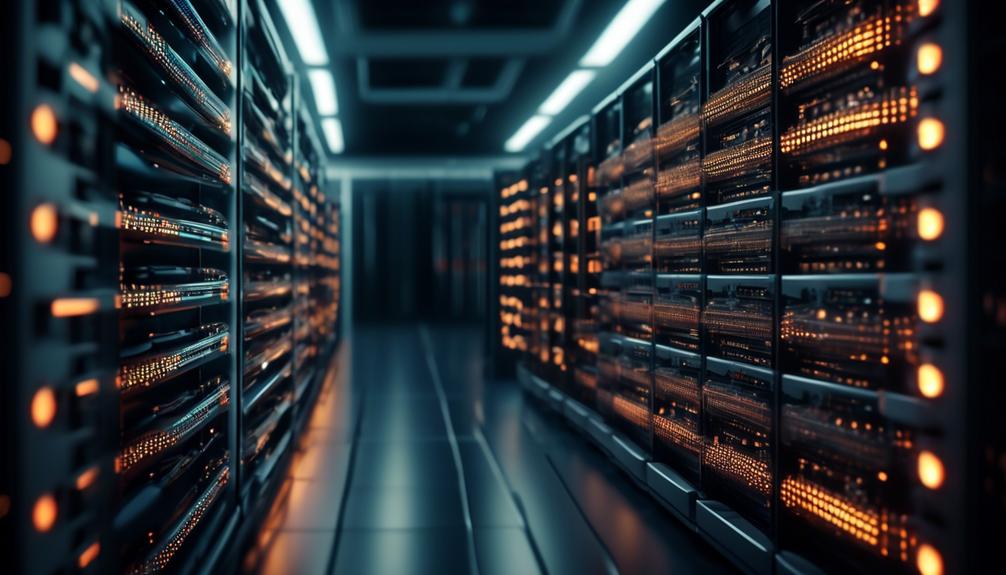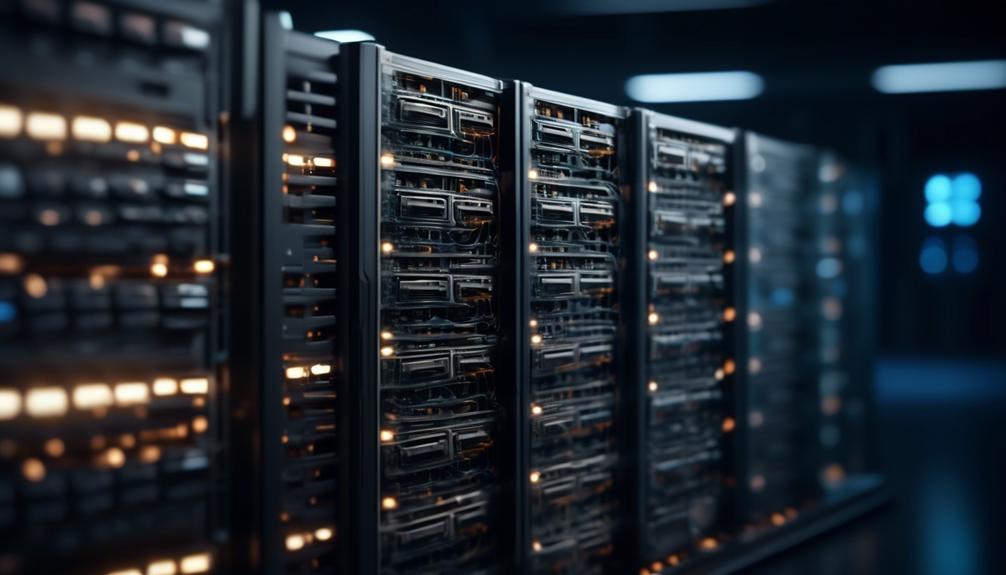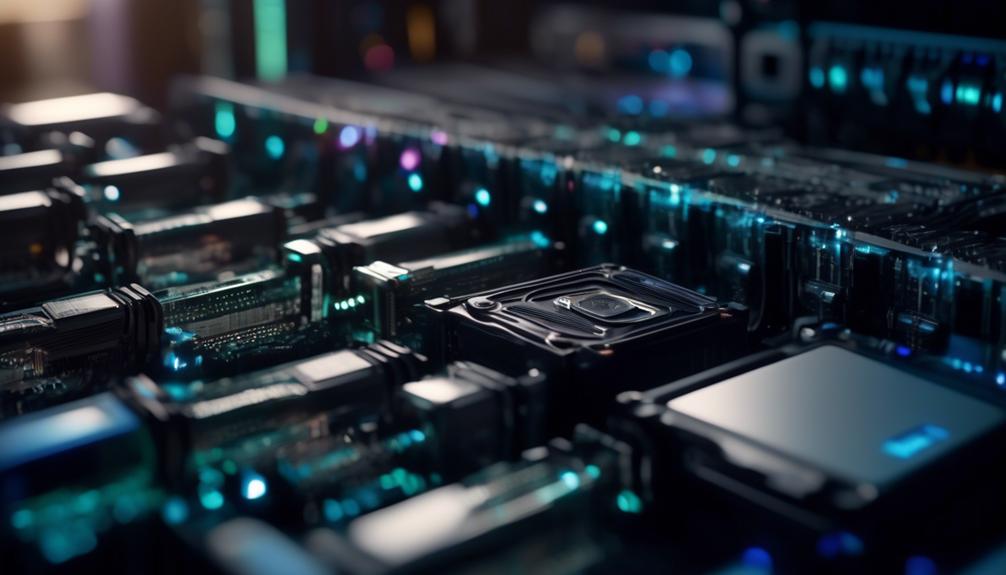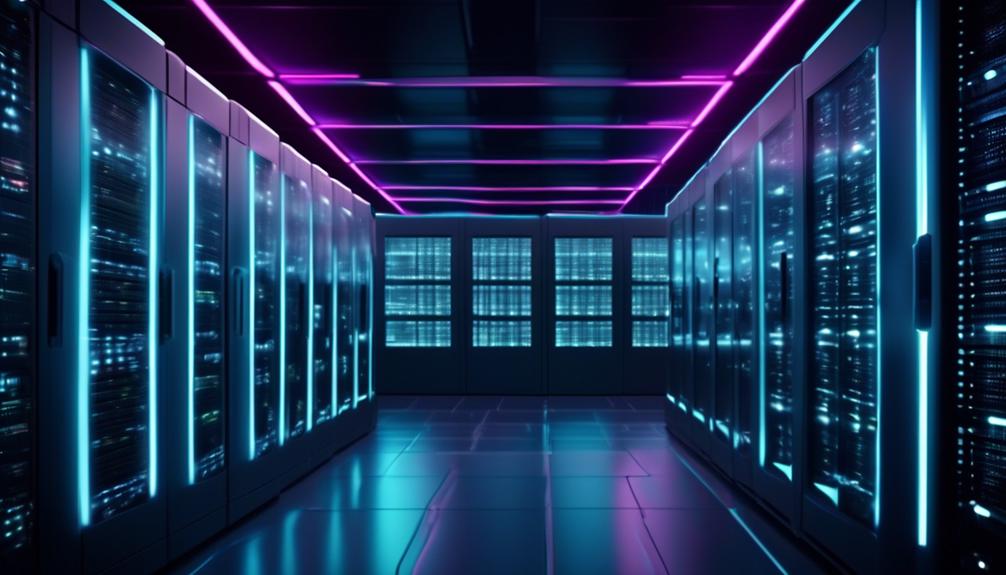In the constantly evolving realm of technology, servers and storage have emerged as indispensable components in computer systems. Servers, whether in the form of software or hardware devices, play a critical role in providing services to other devices on a network. Meanwhile, storage encompasses the vital capability of securely storing data for extended periods. Understanding the nuances between servers and storage is essential in comprehending the intricate workings of computer systems. By exploring the diverse functionalities of these components, we can unlock new possibilities and harness the full potential of modern computing. But what exactly distinguishes servers from storage, and how do they integrate to revolutionize the way information is stored, accessed, and shared? Let's peel back the layers and delve into the revolutionary roles of servers and storage.
Key Takeaways
- Servers provide services to other devices on the network, while storage permanently stores data.
- Servers offer functionalities like data delivery, resource sharing, and database management, while storage is used to store and access data, files, and applications.
- Different types of servers include file servers, web servers, database servers, e-mail servers, and application servers, while storage components include hard drives and Solid State Drives (SSD).
- Understanding the difference between servers and storage is crucial in computer systems as both play important roles in network communication and data management.
Definition and Role of Servers

Servers are software or hardware devices that provide services to other devices on a network, delivering data, facilitating resource sharing, and managing databases. Server management involves tasks such as monitoring server performance, configuring settings, and ensuring availability and security. Server virtualization is a technique that allows multiple virtual servers to run on a single physical server, increasing efficiency and reducing hardware costs. It enables administrators to consolidate server resources, allocate them as needed, and easily manage and scale the virtual servers. Server virtualization also offers benefits such as improved disaster recovery, simplified server provisioning, and reduced power consumption. Understanding server management and server virtualization is crucial for organizations seeking to optimize their network infrastructure, streamline operations, and achieve cost savings. By leveraging these technologies, businesses can enhance flexibility, scalability, and overall efficiency in their IT environment.
Types of Servers
File servers, web servers, database servers, e-mail servers, and application servers are some of the various types of servers that provide specific functionalities in computer systems. File servers are responsible for delivering files to client computers, while web servers offer web pages. Database servers run Database Management Systems (DBMS) to create and manage a database. E-mail servers send and receive e-mails using the standard e-mail protocol. Application servers provide facilities for creating web applications and a server environment. Each type of server has its own advantages and benefits. File servers allow for centralized storage and easy file access, web servers enable website hosting and online services, database servers provide efficient data management, e-mail servers facilitate communication, and application servers support the development and deployment of web applications. Understanding the different server types is crucial in building and managing a robust computer system.
Definition and Role of Storage

What is the role of storage in computer systems and why is it important to understand? Storage plays a crucial role in computer systems by providing a component that can store data for a long time. It offers long-term access to data, ensuring that information can be retrieved and utilized when needed. Understanding the role of storage is important for effective data management and ensuring the availability of critical information. Storage components, such as hard drives and Solid State Drives (SSD), are non-volatile, meaning data is not lost when the device loses power. By comprehending the importance of storage and its role in long-term data access, individuals can make informed decisions about how to store and manage their files, ensuring the security and availability of their valuable information.
Difference Between Servers and Storage
The distinction between servers and storage lies in their respective functionalities within a computer system. A server provides services to other devices on the network, while storage is used to permanently store data. Servers offer functionalities such as data delivery, resource sharing, and database management, enabling clients to obtain services. On the other hand, storage components like hard drives and SSDs provide long-term access to data, files, and applications. While servers and storage serve different purposes, they can be integrated to enhance overall system performance. The integration of servers and storage allows for efficient data management, improved scalability, and enhanced reliability. However, there are also drawbacks to consider, such as increased complexity and potential performance bottlenecks. Therefore, the decision to use servers and storage together should be based on the specific needs and requirements of the computer system.
Importance of Understanding Servers and Storage

Understanding the distinction between servers and storage is crucial in computer systems, as both play vital roles in network communication and data management. Here are four reasons why understanding server management and data storage management is important:
- Efficient resource allocation: By understanding servers and storage, businesses can optimize resource allocation. They can determine the right balance between server capacity and storage capacity, ensuring that both are utilized effectively.
- Enhanced data security: Proper server management and storage management help in implementing robust security measures. This includes setting up firewalls, encryption protocols, and access controls to protect sensitive data from unauthorized access.
- Improved performance: Understanding server and storage management allows businesses to optimize their infrastructure for better performance. This includes load balancing, data caching, and storage tiering, which can significantly improve the speed and responsiveness of network communication and data retrieval.
- Cost savings: By effectively managing servers and storage, businesses can avoid unnecessary expenses. They can identify and eliminate underutilized resources, optimize storage capacity, and reduce energy consumption, resulting in cost savings.
Server Functionalities
Servers offer a wide range of functionalities that are essential for network communication and data management. One of the key functionalities is server management, which involves monitoring, configuring, and maintaining servers to ensure their optimal performance. Server management includes tasks like software updates, security patches, and resource allocation. Another important functionality is server virtualization, which allows multiple virtual servers to run on a single physical server. This helps in maximizing server resources and improving efficiency. Server virtualization also offers benefits such as easier server deployment, better scalability, and reduced hardware costs. By leveraging server management and virtualization, organizations can streamline their operations, enhance data security, and improve overall system performance. It is crucial for businesses to understand and utilize these functionalities to stay competitive in today's rapidly evolving digital landscape.
Storage Components

Storage components play a crucial role in computer systems by providing long-term data storage and access. Here are four important aspects of storage components:
- Storage Technologies: Storage components employ various technologies to store and retrieve data. Traditional hard disk drives (HDD) use magnetic storage to store data on rotating platters, while Solid State Drives (SSD) use flash memory to store data electronically. Newer technologies like Non-Volatile Memory Express (NVMe) offer even faster data access speeds.
- Data Retention: Storage components ensure that data remains intact and accessible over extended periods. They employ techniques like error correction codes and redundancy to protect against data loss or corruption. Additionally, storage systems often utilize backup and replication strategies to further safeguard critical data.
- Capacity and Scalability: Storage components come in different capacities, ranging from terabytes to petabytes, allowing organizations to accommodate growing data needs. Furthermore, storage systems can be easily expanded by adding additional drives or scaling up to larger storage arrays.
- Performance and Speed: Storage components play a crucial role in determining the speed at which data can be accessed and retrieved. Factors such as the storage technology used, interface type (e.g., SATA, SAS, or PCIe), and the presence of caching mechanisms influence the performance of storage components.
Understanding storage components and their technologies is essential for effective data retention and management in computer systems.
Server and Storage Integration
The integration of servers and storage is a fundamental aspect of efficient and reliable data management in computer systems. Server and storage management involves combining these two components to optimize performance and streamline operations. By integrating servers and storage, organizations can experience several benefits. Firstly, it allows for better resource utilization and scalability, as storage capacity can be easily expanded to meet growing data demands. Secondly, it enables faster and more efficient data access, as servers can directly access stored data without requiring additional network transfers. Additionally, server and storage integration simplifies management and reduces administrative overhead, as it consolidates the management of both components into a single interface. Overall, integrating servers and storage enhances the overall performance, reliability, and cost-efficiency of data management in computer systems.
Frequently Asked Questions
What Are Some Examples of Server Functionalities Other Than Data Delivery, Resource Sharing, and Database Management?
Some additional examples of server functionalities, apart from data delivery, resource sharing, and database management, include cloud computing and virtualization. These functionalities enable efficient resource allocation, scalability, and flexibility in managing and accessing data.
How Does a Web Server Differ From an Application Server?
A web server and an application server differ in their functionalities and use cases. A web server primarily delivers web pages, while an application server provides facilities for creating web applications and a server environment.
Can a Single Server Simultaneously Serve Multiple Clients for Different Purposes?
Yes, a single server can efficiently serve multiple clients for different purposes. This benefits organizations by optimizing resource utilization and reducing costs, as a single server can handle various tasks simultaneously, enhancing overall efficiency and productivity.
What Are Some Common Storage Components Other Than Hard Drives and Ssds?
Some common storage components other than hard drives and SSDs include Network Attached Storage (NAS) devices, which provide centralized storage and file sharing capabilities over a network.
How Does the Integration of Servers and Storage Contribute to Network Communication and Data Management?
The integration of servers and storage enhances network communication and data management by providing benefits such as improved efficiency, streamlined processes, and optimized resource allocation. This integration ensures seamless operations and facilitates effective data handling in computer systems.
Conclusion
In the dynamic realm of technology, servers and storage have emerged as indispensable elements in computer systems. Servers play a crucial role in network communication and service provision, while storage ensures efficient data management and long-term accessibility. By understanding the intricate functionalities of servers and storage, we can unlock new possibilities and fully harness the potential of modern computing. These revolutionary components have transformed the way information is stored, accessed, and shared, paving the way for a future of boundless technological advancements.


